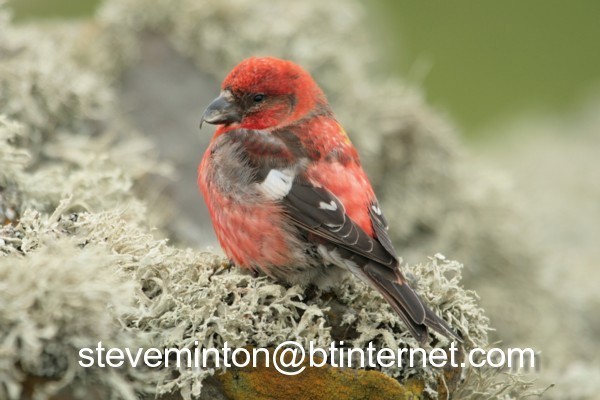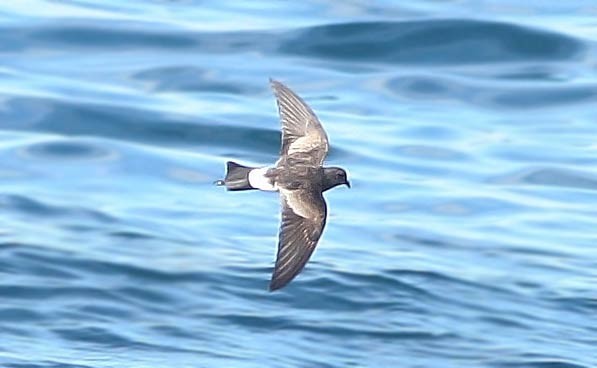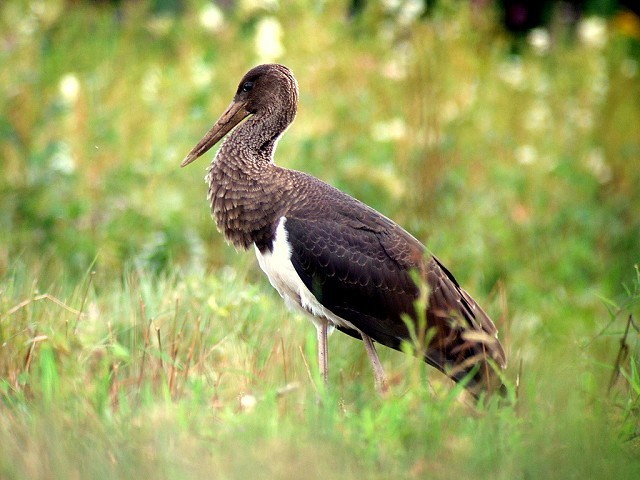The week at a glance
- Two-barred Crossbill irruption ongoing in Shetland and Orkney
- Another potential Yelkouan Shearwater in Cornwall

Two-barred Crossbill, Sumburgh, Mainland, Shetland (Photo:
Steve Minton)
Two-barred Crossbills are still very much the talking point for many, as hopes rise for a southerly push with every new arrival that appears way up on Orkney and Shetland. After the amazing appearance of 16 birds (at the end of the review period last week) on 6th, it was hard to second-guess what would happen next. Well, on 7th four birds, including a male, arrived at Windwick, South Ronaldsay (Orkney) and the six birds at Sumburgh Head, Mainland (Shetland) became at least eight, with a leap to at 13 or more on 8th. On the 9th, this remarkable group became larger still with 15 birds during the morning, rising to an incredible 18+ by close of play. Come the 11th, the Sumburgh flock had faded away a little (“only” 11 birds there). On Fair Isle (Shetland), the group of nine juveniles was still in place to 7th, with eight birds there until 12th, while further new singles included a male reported at Tarbet, Harris (Outer Hebrides) on 7th-8th, on North Ronaldsay (Orkney) on 8th (still present to 12th at least), Mid Yell (Shetland) on 9th and at Tresta Beach, Foula (Shetland) on 12th. The first arrival of this record-breaking invasion appeared only on 20th July, but since then at least 45 birds (with 50+ a more probable figure) have been found (with only two away from Shetland and Orkney - last week's bird on St. Kilda and this week's bird on Harris). Will any of these birds, or any that follow, drift “down south”? There must be a reasonable chance, but it may be a week or two (or longer) before that actually happens. Once again, observers at Pendeen (Cornwall) had a possible Yelkouan Shearwater fly by, this one on 13th, and a “probable” was seen from nearby St. Ives, heading west, in the morning of the same day. We may be edging ever closer to seeing this tough-to-confirm species appear on the British List. It seems that the bird seen from Berry Head in Devon on July 29th was photographed (contrary to initial reports) and they have already been given a “thumbs up” by some seabird experts...

Wilson's Storm-petrel, At sea, Cornwall (Photo:
Gary Thoburn)

Great Shearwater, At Sea, Isles of Scilly (Photo:
Steve Rogers)
Top pelagic prize this week went to the Fea's Petrel seen (from land) off Bridges of Ross (Co. Clare) on 13th, where the seawatching hardcore also enjoyed seven Sabine's Gulls, a couple of Pomarine Skuas and seven Sooty Shearwaters on the same day. In the waters off South Ronaldsay, the summer-plumaged White-billed Diver continued to delight observers on 7th-11th with another reported “recently” from Dunnet Head (Highland). The day-long pelagic on the Scillionian III returned to the birding calendar this year on 10th, but the rough seas ensured many were laid low by mal de mer and the birds were pretty hard to come by too. A Wilson's Storm-petrel was the pick of the bunch, with two Great Shearwaters, four Cory's Shearwaters and two Grey Phalaropes the other highlights. Other Great Shearwaters this week were noted from Porthgwarra (Cornwall) on 9th, 11th and 12th (two birds seen on the latter date), from Berry Head (Devon) on 9th, Pendeen (Cornwall) on 10th and 13th (when four were seen) and at least three were seen from a pelagic off Scilly on 10th. On 13th, five Great Shearwaters flew past St. Ives (Cornwall), nine were seen from Porthgwarra and 11 were seen from Pendeen, with birders at the latter site also recording 16 Cory’s Shearwaters (and 12 were seen from Lizard Point in Cornwall on the same date). Further Cory’s this week included singles from the regular Scillonian III crossing to Scilly on 8th, off Helvick Head (Co. Waterford) and Sea Palling (Norfolk) on 9th, past Porthgwarra and Pendeen on 10th. “PG” then saw a single Cory’s fly by on 12th and two were seen there on 13th. In Devon, four Cory’s were seen from Prawle Point on 13th while singles were seen from St. Ives and, in Dorset, from Portland Bill. As with last week, it was Porthgwarra, and Berry Head, that seemed to fare best with Balearic Shearwaters, the former logging double figures on most days through the week, with the latter managing at least three dates with 10 or more. However, on 13th, St. Ives weighed in with 33, while Pendeen scored 27. Others were noted along the south coast to Kent, with others seen in Suffolk, Ayrshire and County Mayo amongst others, with the week’s tally nudging easily through the 160-bird mark. A handful of Sooty Shearwaters were seen in the North Sea on the back of a brisk northerly breeze on 8th, which also saw single Long-tailed Skuas fly past Whitburn (Co. Durham) and Cley and Sheringham (Norfolk) with single adult Sabine's Gulls past Holme (Norfolk) and Hartlepool Headland (Cleveland) on the same date. The previous day, two juvenile Sabine's Gulls were noted from Butt of Lewis, Lewis (Outer Hebrides). A Sabine’s Gull was also seen from the Scillonian III crossing to Scilly on 8th, with one also noted from Long Nab, Burniston (North Yorkshire) on the same day, while on 9th, an adult was found at Heysham (appearing again on 10th) and one was seen from a Scilly pelagic. In Highland, an adult Sabine’s Gull was seen at sea near Red Point on 10th, and on 12th, singles were seen off Branksome Chine (Dorset) and Spurn (East Yorkshire). As well as the Long-tailed Skuas seen on 8th, another was seen from Spurn (East Yorkshire) on 10th. Pomarine Skuas were generally in pretty short supply: two were seen from Porthgwarra on 7th, while two adults at Theddlethorpe (Lincolnshire) on 9th and three off St. Bees Head (Cumbria) on 10th were also of note. Also on 10th, back in County Mayo, 19 Sooty Shearwaters seen off Annagh Head, the highest total of the autumn, until 13th when 30 were seen from Pendeen.

Black Stork, Crawcrook, Durham (Photo:
Brian Bullough)

Black Stork, Newburn, Northumberland (Photo:
Andy Booth)

Spoonbill, Kinneil Lagoon, Forth (Photo:
John Linskey)
Aside from the family groups in Somerset, the only other Cattle Egrets this week were seen at Ower Causeway, Poole Harbour (Dorset) on 10th and around Cley Marshes NWT and Blakeney Freshmarsh (Norfolk) on 12th-13th. Around 20 Spoonbills were reported this week, including the long-staying quartet at Cley Marshes NWT (Norfolk) and the septet at Middlebere (Dorset) for much of the week (three of the Cley birds moved to Stiffkey on 10th). The bird at Rutland Water (Leicestershire) remained to 9th at least and one was also at the Newport Wetlands (Gwent) from 7th-10th. The two adults at Kinneil Lagoon (Forth) were still present to 10th at least and one was seen at the Inland Sea (Anglesey) on 10th. The summering Common Cranes remained near Crudgington (Shropshire) to 11th, while at least one bird was still at Welney WWT (Norfolk) to 9th. In County Durham a superb juvenile Black Stork was found at Greenside on 8th and remained there until mid-afternoon of 9th, when it flew off northeast. On 10th, the bird was re-found at Newburn (Northumberland) where it stayed until 11th when it popped back to Durham, and the Clara Valley LNR, and remained in the general area to 13th. This may well be the Black Stork seen for a few minutes at Cramlington (Northumberland) at the end of July - there can’t be too many Black Storks in the area... In Hampshire, the White Stork was reported at Ibsley Water Meadows on 7th and another was seen at Britford Water Meadows (Wiltshire) on 11th and again on 13th. A remarkable report, on 13th, was of a group of at least 30 Glossy Ibises flying over Hale (Cheshire) which headed northwest towards Seaforth – the experienced observer saw the birds well, but where will they appear next?
The drake Ferruginous Duck remained at Chew Valley Lake (Somerset) until 13th, while the eclipse drake Lesser Scaup was again at Balgray Reservoir (Clyde) on 10th-12th at least. Still in Scotland, at least one Surf Scoter was noted off Blackdog (Aberdeenshire) on 9th-10th. In County Wexford, the summering young drake King Eider was still to be found around Lady’s Island Lake until 12th at least, while another popular young drake, the first-summer drake Hooded Merganser at Radipole Lake RSPB (Dorset) remained to 13th.

Honey Buzzard, Wykeham Forest, North Yorkshire (Photo:
Dave Mansell)
A male Red-footed Falcon was seen at Glen Moriston (Highland) on 9th and a female was reported at Tarbet, Harris (Outer Hebrides) on 11th. Up to three Honey Buzzards continued to be seen at Swanton Novers (Norfolk) and at Wykeham Forest (North Yorkshire) at least two birds remained during the week. Seven Honey Buzzards were reported near Beverley (East Yorkshire) on 7th, with singles noted at Venus Pool NR (Shropshire) on 9th and Bough Beech Reservoir (Kent) on 10th. A male Montagu's Harrier was at Trimley Marshes SWT (Suffolk) on 8th and two “ringtails” were seen at Gibraltar Point (Lincolnshire) on 13th.

Buff-breasted Sandpiper, Doonfoot, Ayrshire (Photo:
Fraser Simpson)

Spotted Sandpiper, Burniere Point, Cornwall (Photo:
Colin Selway)

Pectoral Sandpiper, Gibraltar Point NNR, Lincolnshire (Photo:
Russell Hayes)
A Wilson's Phalarope was a nice surprise for birders at Grindon Lough (Northumberland) on 13th and the second Baird's Sandpiper of the autumn arrived at Balgarva, South Uist (Outer Hebrides), also on 13th. Other Nearctic shorebirds noted this week included the adult summer American Golden Plover, on the high-tide again at Elmley Marshes RSPB (Kent) on 7th-10th, the summer-plumaged Spotted Sandpiper at the Amble dam sluice, on the Camel Estuary (Cornwall) to 7th and the two Buff-breasted Sandpiper which appeared last week remaining on North Ronaldsay (Orkney) to 8th and at Doonfoot (Ayrshire) to 9th. The lingering Pectoral Sandpiper remained at Gibraltar Point NNR (Lincolnshire) to 7th, while belated news from Kent concerned another Pectoral Sandpiper, at Elmley Marshes RSPB, on 4th-6th at least. A juvenile Kentish Plover spent 10th at Keyhaven Marshes (Hampshire) and a Dotterel found at Portland (Dorset) on 8th, was the first record of the autumn for this always-delightful species.

White-winged Black Tern, Crosby Marine Park, Lancashire (Photo:
John Donnelly)
An adult Ring-billed Gull was still enjoying the craic at Nimmo’s Pier (Co. Galway) on 8th, with a first-summer bird at Myroe Levels (Co. Derry) on 12th. An Iceland Gul was still to be found in Sligo harbour (Co. Sligo) in the early part of the week, along with birds in County Antrim, at Corbally Road Reservoir and Ramore Head, both on 9th. Also at Ramore was a Glaucous Gull, which remained to 12th at least, along with single birds in the harbour at Brora (Highland) on 8th-11th and Fraserburgh (Aberdeenshire) on 10th. Caspian Gulls included a first-winter at Brighton Marina (East Sussex) on 7th (first seen there on 6th) and an adult was found at Rutland Water (Leicestershire) on 7th (reappearing there on 11th). A mini-arrival of White-winged Black Terns livened things up this week, with five birds discovered; an adult was found at Crosby Marine Park (Lancashire) on 7th and spent it’s time commuting between there and Seaforth LWT. On 8th, one was found at Slapton Ley (Devon) and was followed by one at Thamesmead (London) on 10th-13th. In Scotland, singles were at Loch of Strathbeg (Aberdeenshire) and at Inverness Airport (Highland) on 11th, with the latter still present on 13th.

Lesser Grey Shrike, Hartland Moor, Dorset (Photo:
Gary Thoburn)
Following on from a juvenile Citrine Wagtail on North Ronaldsay until 8th it, or another juvenile was found on Mainland Orkney, near Stenness on 10th. A Short-toed Lark was a great find on the far west coast of Scotland on 12th, arriving on Tiree (Argyll) and still present the following day, while Fair Isle claimed its second August Thrush Nightingale of the decade with an arrival alighting on 13th. In Dorset, the female Lesser Grey Shrike was still to be found near Middlebere from 7th-12th at least and the juvenile Red-backed Shrike found at the end of last week remained on the Farne Islands (Northumberland) to 10th at least. In Argyll, on Tiree, a Hoopoe has been reported recently near Kellis.

Melodious Warbler, Sumburgh, Mainland, Shetland (Photo:
Micky Maher)
The Melodious Warbler at Sumburgh (Shetland) remained in place to 9th while an Icterine Warbler was trapped, ringed and released at Landguard NR (Suffolk) on 7th. On 8th, the autumn’s first Barred Warbler appeared (somewhat predictably after a brief northerly) on the Farnes and was still present to 10th.

Rose-coloured Starling, Bunessan, Mull, Argyll (Photo:
Bryan Rains)
The round-up finishes with Rose-coloured Starlings. All three birds this week were in Scotland; one was at Bunessan, Mull (Argyll) which was reported belatedly for 6th, but was still present on 8th, investigating a garden feeder. Other Rose-coloured Starlings were seen at Bowmore, Islay (Argyll) on 12th-13th and at Cromdale, near Grantown-on-Spey (Highland) on 13th.
Photo of the Week

Kittiwake, Farne Islands, Northumberland (Photo:
Marcus Conway)
We've become accustomed to seeing images depicting 'nature in the raw', but it's still difficult to avoid imagining what a horrific experience it must be for the victims of predation. An excellent example is the Marcus Conway's sequence of images of a Kittiwake chick being eaten alive by a Herring Gull. This image in particular emphasises the helplessness of the prey against the might of such a powerful predator. That said, one still has to wonder how the Herring Gull could manage to swallow the Kittiwake whole, and to admire this species' ability to exploit such a wide range of food sources.
Other notable photos

Turnstone, Blakeney Harbour, Norfolk (Photo:
Andrew P. Chick)

Great Crested Grebe, Willington GPs, Derbyshire (Photo:
Richardp)

Barn Owl, Undisclosed Site, East Sussex (Photo: anon)

Nightjar, undisclosed site, Nottinghamshire (Photo:
Dave Winnard)

Peregrine Falcon, Scarborough, North Yorkshire (Photo:
Steve Race)

Swallow, Spain (Photo:
Steve Fletcher)

Common Kingfisher, Marston on Dove, Derbyshire (Photo:
Richardp)

Great Spotted Woodpecker, Milnthorpe, Cumbria (Photo:
Pauline Greenhalgh)

Robin, Over Haddon, Derbyshire (Photo:
Robert Askew)

Short-eared Owl, undisclosed site, West Yorkshire (Photo:
Ian Scott)

Long-eared Owl, Green Withens Reservoir, West Yorkshire (Photo:
Darrell J Prest)

